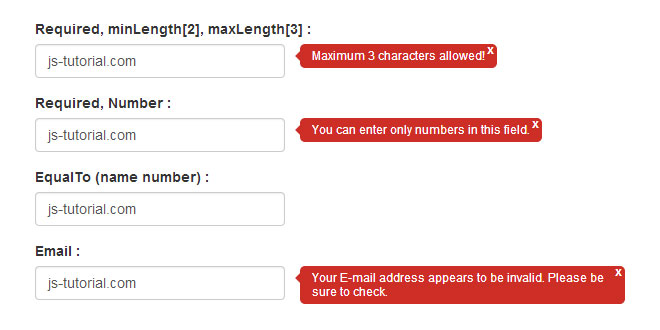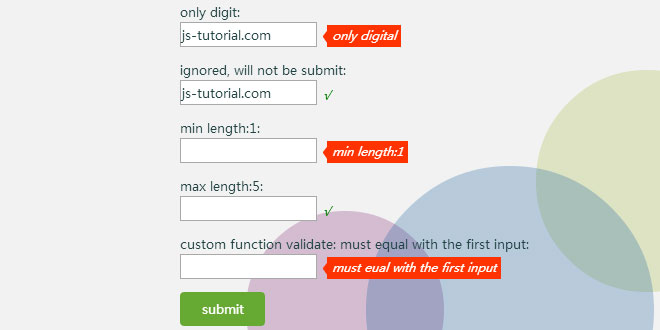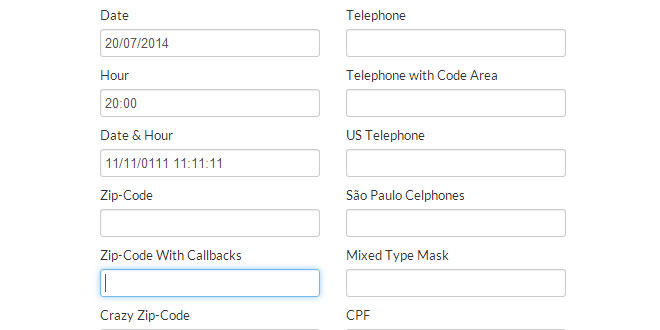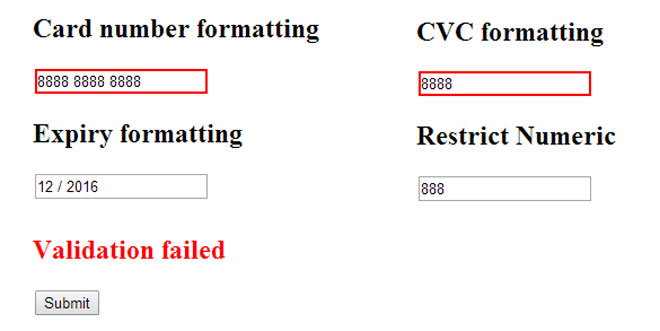- Overview
- Documents
- Demos
Validetta is a tiny jQuery plugin which you can do client-side validation of your forms. It aims to decrease your burden with easy usage and flexible structure.
What can be done?
- You can check fields whether it is empty or not or it is chosen or not.
- You can do e-mail check.
- You can do number check.
- You can check if the two fields are equal to each other.
- You can check credit card number validation.
- You can limit number of characters written to fields.
- You can limit number of choice of multiple select box or check box.
- You can use remote validator.
- By creating your own regular expression, you can check fields according to this regular expression.
Source: lab.hasanaydogdu.com
1. INCLUDE CSS AND JS FILES
<link href="validetta/validetta.css" rel="stylesheet" type="text/css" media="screen" > <script type="text/javascript" src="http://code.jquery.com/jquery-latest.min.js"></script> <script type="text/javascript" src="validetta/validetta.js"></script>
You can include language file if you want.
<script type="text/javascript" src="validetta/languages/validettaLang-tr-TR.js"></script>
2. HTML
Add data-validetta attribute to element which you want to control.
<input type="text" name="exm" data-validetta="required,minLength[2],maxLength[3]" />
3. JAVASCRIPT
$(document).ready(function(){
$("#form").validetta();
});
4. VALIDATORS
| Name | Description |
|---|---|
| required | checks fields whether it is empty or not or it is chosen or not. |
| number | checks fields if it is consist of number or not. |
| checks email if it is valid or not. | |
| creditCard | checks credit card number written to fields if it is valid or not. |
| equalTo[input_name] | checks if the two fields are equal to each other according to input name. |
| minLength[x] | checks fields if it is consist of minimal X character. |
| maxLength[x] | checks maximal X character entry to the area. |
| minChecked[x] | checks minimal X option if it is marked or not. |
| maxChecked[x] | checks maximal X option if it is marked or not. |
| minSelected[x] | checks minimal X option if it is chosen or not. |
| maxSelected[x] | checks maximal X option if it is chosen or not. |
| custom[regexp_name] | checks if field is suits to identified ordered expression or not. |
| remote[validator] | checks fields using remote validator. |
5. OPTIONS
$('#form').validetta({
/** You can display errors as inline or bubble */
display : 'bubble', // bubble or inline
/**
* Error template class
* This is the class which will be added to the error message window template.
* If you want special style, you can change class name as you like with this option.
* Error message window template : <span class="errorTemplateClass">Error messages will be here !</span>
*/
errorTemplateClass : 'validetta-bubble',
/** Class that would be added on every failing validation field */
errorClass : 'validetta-error',
/** Same for valid validation */
validClass : 'validetta-valid', // Same for valid validation
/**
* Error window's close button.
* if you want to deactive error window's close button, set it false
* You can add a close button for error windows, and you can add specific class to it
*/
errorClose : true,
/** The html class that will add on element of HTML which is closing the error message window */
errorCloseClass : 'validetta-bubbleClose',
/* To enable real-time form control, set this option true. */
realTime : false,
/** Costum reg method variable */
custom : {},
/** Remote validation method variable */
remote : {},
/** Callback functions */
onValid : function(){},
onError : function(){}
});
6. CALLBACKS
There are two different callbacks you can declare when setting up the validation.
- onValid : This function to be called when the user submits the form and there is no error.
- onError : This function to be called when the user submits the form and there are some errors.
$('#form').validetta({
onValid : function( event ) {
event.preventDefault(); // Will prevent the submission of the form
alert( 'Nice, Form is valid.' );
},
onError : function( event ){
alert( 'Stop bro !! There are some errors.');
}
});
7. REMOTE VALIDATION
This option allows you to perform server-side validation. By using this option you can validate the value given by the user on server side before the form gets submitted. The validation function will send an ajax request to URL declered in remote options.
The form will get the class validetta-pending while the server is being requested.
The response from the ajax request must be a JSON formatted object, containing the properties "valid" and "message".
Remote validator settings
$('#form').validetta({
remote : {
validator_name : {
// Here, you must use ajax setting determined by jQuery
// More info : http://api.jquery.com/jquery.ajax/#jQuery-ajax-settings
type : 'POST',
url : 'remote.php',
datatype : 'json'
}
}
});
An example for remote.php
<?php
$response = array( 'valid' => false, 'message' => 'Sorry, Something went wrong!');
if( isset($_POST['username']) ) {
if ( $_POST['username'] !== 'validetta' ) {
$response = array( 'valid' => false, 'message' => 'This username is already taken!' );
} else {
$response = array( 'valid' => true );
}
}
echo json_encode($response);;
 JS Tutorial
JS Tutorial




